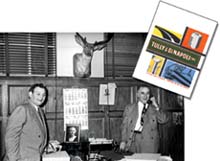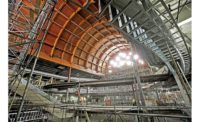Companies
Tully Construction Bursts on NY Scene After 80 Years of Building Its Hometown
 |
| PUSHING Peter Tully (above) is in charge at WTC site for firm co-owned by brothers (l. to r.) Ken Jr., Peter, Tom and Jimmy. (Photo by Michael Goodman for ENR) |
For months, Peter Tully, the scion of one of New York City's most durable but low-profile contracting families, was dogged by a writer stalking a key participant in the post-9/11 World Trade Center cleanup and renovation for an account of the project that later appeared in Atlantic Monthly magazine and as a book.
Despite the firm's pivotal role as one of the first construction early responders to the devastating lower Manhattan attack, Tully characteristically refused to talk to him. The writer's controversial epic later drew howls from a number of Ground Zero insiders and observers, including Tully's own father. But Peter Tully has come to relish its description of the firm, which he now leads, as the site's "red meat guys."
 region region |
| (Photo courtesy of Tully) |
Voraciously pursuing the steak and avoiding the sizzle has been a Tully Construction Co. Inc. hallmark for decades.
The Queens, NY-based heavy-highway contractor quietly has grown into a major player in New York region construction, at the skyline level and below, since the glory days of Robert Moses-driven public works. Tully's resume is a rundown of iconic city megaprojects--from infrastructure for the 1939 and 1964 World's Fairs and foundations at the trade center to the $304-million rebuilding of the giant Newtown Creek wastewater treatment complex under way today. A company brochure from the 1960s, the last time it used such a marketing tool, notes the firm's link to the "Big Ones" over the previous four decades.
What began as a one-truck coal-hauler in the 1920s today is a diversified business with annual revenue approaching $500 million. But the corporate trappings of growth and success haven't grown with the organization, now owned by four Tully brothers, grandsons of the co-founder. "They don't want the publicity. It's not valuable," says Frank McArdle, managing director of the General Contractors Association of New York Inc., of which Peter Tully is a past president. "In public works, marketing does not help you on the day they open the envelope."
 |
| MOBILIZED Tully crews and equipment devoured the "pile" for months after the 9/11 attack. (Photo by Michael Goodman for ENR) |
Even as its track record at Ground Zero spotlights the firm and catapults it into more visible construction arenas, Tully Construction clings hard to its low-bid culture, a clannish management style and a hands-on work ethic driven by Peter Tully, president since 1995.
The firm's old-fashioned Irish green logo, ubiquitous at Ground Zero, still rallies the troops. "His employees bleed Tully green," says John Lekstutis, a long-time Peter Tully associate who is president of The LiRo Group, a Syosset, N.Y., engineer that has worked with the firm on lower Manhattan utility reconstruction since 9/11. "He takes care of his people and they take care of him."
The reverence for the company's roots is apparent at Tully headquarters, a nondescript company-owned brick building in the Flushing section of Queens that faces rusted elevated highways, an industrial zone and warehouses festooned with signs in Korean, representative of the area's large immigrant population now.
Bars on first-floor windows attest to neighborhood changes since Tully built its headquarters in 1950. A large oil portrait of grandfather Edward A. Tully in younger days still hangs prominently in the austere "lobby." He and Vincent P. "Pete" DiNapoli started the firm in 1924 as Tully & DiNapoli Inc. It floundered in the Depression, but later, with Moses steamrolling megaprojects, was "making money by the carload," according to author Robert Caro's critical 1974 biography of Moses, The Power Broker.
With no Di Napoli heirs, ownership shifted in the 1970s to four sons of Edward Tully who were involved in the firm. Kenneth Tully Sr., father to the current sibling owners, assumed the helm and later full control just as the city's budget and area public works were collapsing. "The 70s were terrible," says Ken Tully Sr., who says he went as far as Ecuador and Nigeria to find enough work to keep the firm afloat. Memories of the old days are still vivid for the brothers, who all started working for the firm in their teens as part-time laborers. "My father kept our feet to the fire and told us to always prepare for the bad times," says Peter Tully. "That's why we don't take a lot of money out of the company."
Leadership transition to the no-nonsense Peter Tully, 42, was predictable, despite his position as the middle child of seven. With business and law degrees, he also worked closest to his father. "Peter thinks the most administratively," says the elder Tully. "He seemed to fit my perspective of an executive officer."
 |
| VERY FAST TRACK World Trade Center subway rebuild was high-pressure, high-risk job. (Photo courtesy of Tully) |
Peter Tully learned the political ropes early on as the firm weathered a probe by then-city controller Elizabeth Holtzman over alleged financial issues associated with its investments in concrete businesses. The dispute was settled and never prosecuted, but it cost Tully the ability to bid city work for at least a year. "They were informally told they'd never be considered responsible," says McArdle. That drought pushed the contractor into new areas outside of city public works, particularly landfill closure and garbage hauling, which have since proved lucrative. "It required financial ability and bonding, both of which we had," says Peter Tully.
But Peter's ascension to the top also came amid a personal crisis, the long illness of his first wife, Donna, and her eventual death from leukemia in 1997. That loss left him with three young children. To cope, "I threw myself into the business," says Tully, who has since remarried. His family connections at work were a key support. Among the other brothers, there is a key division of labor. Tom, 46, is a civil engineer in charge of the firm's critical estimating function; Jim, 44, manages field operations; and Ken Jr., 40, runs Tully's related asphalt, trucking and recycling units. "They each have their fiefdoms," says Ken Tully Sr. The traditional clan's three sisters are not involved in the firm.
"We get along great," says Tom Tully. "We trust each other and egos don't get in the way, like in other families." He says he still vacations with brother Jimmy. "Their father and mother raised these kids well," says McArdle. "They don't have swelled heads about who they are."
The busy Tully brothers convene their own weekly sessions–the infamous Wednesday dinners–to discuss critical matters and enjoy "male bonding," says Peter Tully. But the firm has embraced "outsiders," such as Thomas F. Olesczuk, vice president of engineering, who joined in 1993 and was a key Ground Zero manager. "I work extra hard because they do," says Olesczuk, known affectionately as "Tommy O" in the firm. "But Pete lets me have all the leeway I want. Big decisions are made behind closed doors, but I'm clued in."
 |
| ROOTS Di Napoli (left) and Edward Tully founded firm that had a piece of most city jobs, including 1939 World's Fair. (Photo courtesy of Tully) |
And there was no decision bigger than Tully's watershed move to commit staff, equipment and resources to lower Manhattan in the wake of the Sept. 11, 2001, attacks. What began as a natural extension of emergency aid from a contractor working on a nearby state road project, ended up as a months-long, 24/7 commitment involving 75% of its 900-person staff.
The city's Dept. of Design and Construction, deputized to manage the massive construction response, knew the Tully organization from past municipal jobs. "They were people who had the financial wherewithal to mobilize and not know when they would get paid," says Kenneth Holden, DDC commissioner. "And since Peter Tully's firm was family-owned, he might have had more to lose."
Tully acknowledges that the work, for which no contract has yet been signed, was eating up $1.2 million a week in payroll. "That's a little scary," he says. "There was no contract and the money was pouring out the door every day. But you couldn't get us away no matter what."
 |
|
(Photo courtesy of Tully)
|
While Tully was one of four prime contractors working in rough quadrants on the 16-acre disaster site, the nature of the debris and each firm's zeal to remove it as fast as possible made it tough to respect borders on a DDC map. "There were conflicts between Tully and the others," says Lekstutis. "But the overall cooperation was phenomenal."
Ground Zero peers credit Tully's relentlessness. "They grabbed this thing with their teeth," says Pablo Lopez, engineer with Mueser Rutledge Consulting Engineers, who was involved with the site's vulnerable concrete "bathtub," which kept the Hudson River at bay. He credits Tully crews in quickly filling in a widening crack on the bathtub's Liberty Street side that threatened the entire structure. "They understood and kept pushing their guys," says Lopez.
The firm's tough stance with union crews caused some grousing among building trades at Ground Zero, who referred to the firm as "Tully-ban." Says one site source: "They were tough with the unions because they were afraid to set a precedent for other jobs."
Peter Tully discounts talk of union griping as "normal problems at the site." He adds, "My relationship with the unions is good. I give it to them straight and I expect them to give it to me straight and not BS me." With Tully, his father and other relatives all serving as NYC contractor association presidents, they were intimately involved in local collective bargaining.
Jimmy Tully, the firm's point man at Ground Zero who was described in Atlantic Monthly as a "New York street tough," was a target for DDC officials as well as for union workers. Stories abound of grueling sessions with Lou Mendes, DDC's burly and fearsome assistant commissioner, over slow work progress. But Mendes now has only praise for the Tully organization. "They're good contractors and good managers and they know what it is to not waste money," he says. "I'll do any job with Jimmy anytime."
But publicity-shy Peter wanted to keep the firm's achievement low profile. "We had to twist his arm to put up a Tully sign down there," says Bill Ryan, Tully's safety manager.
 |
| NICHE Fresh Kills landfill closure was four-year task. (Photo courtesy of Tully) |
Despite Tully's commitment to the job, the risks of site uncertainties and the lack of a contract loomed large throughout the cleanup, and still do. Peter Tully took a lead role in lobbying Washington to obtain indemnification for site contractors. The battle was won months later with the federal government's agreement to set up a $1-billion pool and a captive insurer. But sources say the city now is trying to dip into the pool for expenses related to police and fire personnel.
Also unfinished is final payout to Ground Zero contractors and subs, with some equipment and labor costs still in dispute. DDC's Holden says the city is setting up a claims process for unsettled payments and he expects final closeout by spring. One site source says most firms long-ago recovered costs and that some, including Tully, will earn millions. But another says outside reviews of the firm's cost requests show only minor discrepancies.
 |
| (Photo by Michael Goodman for ENR) |
Tully's enviable position at Ground Zero gave the firm a considerable leg up in other work that cascaded from the initial cleanup job, including replacement of power, telephone, water and sewer lines damaged in the collapse of the Twin Towers and other buildings. The complex work involved intricate scheduling with cleanup crews and keeping myriad utilities happy.
But Tully executives also had their eyes on another prize--the fast-track replacement of 1,500 ft of virtually decimated subway line at the WTC site. Tully Construction had never worked for the Metropolitan Transit Authority, which runs the city's subways, but teamed with A.J. Pegno Construction Corp., College Point, N.Y., a long-time associate with transit experience, to bid the job. The work was estimated to cost $200 million. Tully-Pegno bid it at $92 million and won.
While the final cost escalated with change orders, the joint venture finished the work in an astonishing nine months, in time for the 9/11 one-year anniversary in September 2002. "The critical path method was completely thrown out the window," says Mysore Nagaraja, MTA chief engineer. "This would have taken two years. What we built was a complete subway."
MTA credits Peter Tully's commitment. "He said he would take the risk," says Nagaraja. "He convinced the subs to proceed and said he would make them whole. They could have milked the job." The firm that had never done transit work ended up sharing a $3-million early completion bonus, the largest one that MTA has ever paid, says Nagaraja.
If that stress was not enough for the Tully organization, it also vied successfully with partners Pegno and Yonkers Contracting Co. Inc. for the $544-million program to restore underground train service between the World Trade Center site and New Jersey that also was decimated on Sept. 11. The work, for the Port Authority of New York and New Jersey, is mostly subsidized by the Federal Emergency Management Agency, says Ray Finnegan, PA deputy chief engineer. Complex tunneling on the New Jersey side is ahead of schedule for late March completion and "the team is looking at a $1-million bonus," he notes. Work on the New York side is set to finish in late summer.
 |
| FUTURE Gov. George Pataki's Manhattan transit plan is new lure. |
While Peter Tully's World Trade Center site ambitions shell-shocked some firm managers and caused brother Jimmy to endure ribbing at Ground Zero as "King James" because of the firm's ever-rising site profile, Finnegan credits the right balance of management. "Peter tends to hire people and let them accomplish the right thing, but he is an active participant," says Finnegan, who notes Peter's equal awareness of details on an $800,000 job at LaGuardia Airport. "My father taught me to always check on things," says Tully, whose cell phone seems permanently attached to his ear.
There may be more to check on as Tully seeks out bigger jobs.
New York's worsening budget situation could be a problem. Tom Tully says the city's Dept. of Environmental Protection "has pulled back some RFPs" because of financial constraints. But Peter still sees opportunity in environmental work. In 2000, Tully finished a $100-million closure of the city's Fresh Kills landfill but now is back on site to build a waste transfer station that it also hopes to run.
But even as it grows, Tully intends to stick close to its New York roots.
It is especially eyeing more work in lower Manhattan stemming from FEMA's $4.5-billion pledge to boost transit. On Feb. 8, Gov. George Pataki (R) revealed new details on the plan. Tully already is teamed with Pegno, LiRo and URS Corp. to bid an estimated $450-million rebuild of the aging South Ferry subway station. The URS link is a likely offshoot of Peter Tully's new relationship with Michael Burton, an ex-DDC official who ran Ground Zero operations and is now a URS executive. "I had never even shaken hands with Peter Tully before 9/11," says Burton. "But it's people like him who will win our industry a more favorable impression."
Tully acknowledges the challenge in managing a larger and more diverse firm, but "we were changing anyhow," he says. "This just accelerated it."



